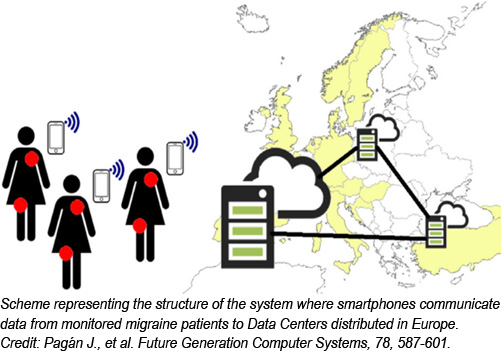Successful simulation of a real-time migraine prediction system
UPM researchers, in collaboration with UCM and Hospital Universitario de la Princesa, have successfully simulated a system that alert patients to an incoming migraine crisis in real time. According to the simulation results, the reliability of this system is over 75%.
In order to improve the quality of life of migraine patients, a team that includes researchers from Center for Computational Simulation (CCS) at Universidad Politécnica de Madrid is developing a wearable device able to predict and alert the incoming pain of these crises.
According to a recent article published with researchers from Universidad Complutense de Madrid (UCM), the effectiveness of prediction and early warning system in real time was tested in a simulation environment with reliability over 75% in average times of 25 minutes.
 These results lay the foundation for the development of a future hardware device that monitors biomedical variables of patients and alerts of the arrival of this crisis.
These results lay the foundation for the development of a future hardware device that monitors biomedical variables of patients and alerts of the arrival of this crisis.
Migraine is a highly prevalent and disabling neurological disease and affects between 12% and 15% of the population worldwide. Migraine worsens the patients’ life and their performance at work or social environment which lead to high cost for private and national health systems in Europe.
The anticipated intake of drugs could prevent pain and improve the quality of life of patients as well as saving economic cost to society. Thus, it is essential an objective prediction of the time when crises occur.
A team of researchers from Center for Computational Simulation at UPM has been working with UCM since various years ago on a processing methodology for the development of a predictive model of migraine crisis. Recently, this team, in collaboration with the Headache Unit of Hospital Universitario de la Princesa de Madrid, has developed a predictive system of a migraine crisis in real time in a simulation environment with reliability over 75% in average times of 25 minutes, enough time to prevent or reduce the pain of the crisis.
In the Josué Pagán opinion, a researcher of this study, “this is a step towards the final implementation of a commercial device that will help patients improve their quality life”.

Besides, this work has tackled the economic impact at both energetic and care level that would mean the implementation of this system in a hypothetical deployment in Europe. When a patient who suffers from migraines is monitored, the data can be processed either in the acquisition sensor of biomedical variables or in a smartphone or data center.
Where and when to process these data have different costs depending on the network, smartphone battery, etc. Thus the new system will be able to optimize the decision of selecting the cheapest process in energy terms.
The system has been optimized for a representation of 2% of migraine sufferers in Europe taking into account the reliability of the prediction models and both the household energy prices in each country (when charging the monitoring devices and smartphone) and industrial costs (data centers). The results yield average savings of €288 million in addition to savings of €1272 million due to the benefits of the migraine prediction.
This work was nominated for best article in the last Summer Simulation Conference held in Seattle (US).
Pagán, J., Zapater, M., & Ayala, J. L. (2018). Power transmission and workload balancing policies in eHealth mobile cloud computing scenarios. Future Generation Computer Systems, 78, 587-601.
Pagán, J., Moya, J. M., Risco-Martín, J. L., &; Ayala, J. L. (2017, July). Advanced migraine prediction simulation system. In Proceedings of the Summer Simulation Multi-Conference (p. 24). Society for Computer Simulation International.
Pagán, J., Orbe, D., Irene, M., Gago, A., Sobrado, M., Risco-Martín, J. L., ... & Ayala, J. L. (2015). Robust and accurate modeling approaches for migraine per-patient prediction from ambulatory data. Sensors, 15(7), 15419-15442.


